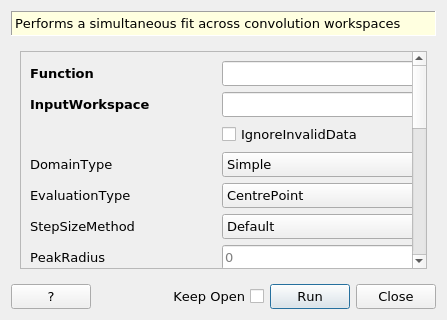\(\renewcommand\AA{\unicode{x212B}}\)
ConvolutionFitSimultaneous v1¶

ConvolutionFitSimultaneous dialog.¶
Summary¶
Performs a simultaneous fit across convolution workspaces
See Also¶
Properties¶
Name |
Direction |
Type |
Default |
Description |
|---|---|---|---|---|
Function |
InOut |
Function |
Mandatory |
Parameters defining the fitting function and its initial values |
InputWorkspace |
Input |
Mandatory |
Name of the input Workspace |
|
IgnoreInvalidData |
Input |
boolean |
False |
Flag to ignore infinities, NaNs and data with zero errors. |
DomainType |
Input |
string |
Simple |
The type of function domain to use: Simple, Sequential, or Parallel. Allowed values: [‘Simple’, ‘Sequential’, ‘Parallel’] |
EvaluationType |
Input |
string |
CentrePoint |
The way the function is evaluated on histogram data sets. If value is “CentrePoint” then function is evaluated at centre of each bin. If it is “Histogram” then function is integrated within the bin and the integrals returned. Allowed values: [‘CentrePoint’, ‘Histogram’] |
StepSizeMethod |
Input |
string |
Default |
The way the step size is calculated for numerical derivatives. See the section about step sizes in the Fit algorithm documentation to understand the difference between “Default” and “Sqrt epsilon”. Allowed values: [‘Default’, ‘Sqrt epsilon’] |
PeakRadius |
Input |
number |
0 |
A value of the peak radius the peak functions should use. A peak radius defines an interval on the x axis around the centre of the peak where its values are calculated. Values outside the interval are not calculated and assumed zeros.Numerically the radius is a whole number of peak widths (FWHM) that fit into the interval on each side from the centre. The default value of 0 means the whole x axis. |
Ties |
Input |
string |
Math expressions defining ties between parameters of the fitting function. |
|
Constraints |
Input |
string |
List of constraints |
|
MaxIterations |
Input |
number |
500 |
Stop after this number of iterations if a good fit is not found |
Minimizer |
Input |
string |
Levenberg-Marquardt |
Minimizer to use for fitting. Allowed values: [‘BFGS’, ‘Conjugate gradient (Fletcher-Reeves imp.)’, ‘Conjugate gradient (Polak-Ribiere imp.)’, ‘Damped GaussNewton’, ‘FABADA’, ‘Levenberg-Marquardt’, ‘Levenberg-MarquardtMD’, ‘Simplex’, ‘SteepestDescent’, ‘Trust Region’] |
CalcErrors |
Input |
boolean |
False |
Set to true to calcuate errors when output isn’t created (default is false). |
ExtractMembers |
Input |
boolean |
False |
If true, then each member of the fit will be extracted, into their own workspace. These workspaces will have a histogram for each spectrum (Q-value) and will be grouped. |
ConvolveMembers |
Input |
boolean |
False |
If true members of any Convolution are output convolved with corresponding resolution |
OutputCompositeMembers |
Input |
boolean |
False |
If true and CreateOutput is true then the value of each member of a Composite Function is also output. |
ResultXAxisUnit |
Input |
string |
MomentumTransfer |
The unit to assign to the X Axis of the result workspace, defaults to MomentumTransfer. Allowed values: [‘AtomicDistance’, ‘Degrees’, ‘DeltaE’, ‘DeltaE_inFrequency’, ‘DeltaE_inWavenumber’, ‘dSpacing’, ‘dSpacingPerpendicular’, ‘Empty’, ‘Energy’, ‘Energy_inWavenumber’, ‘Label’, ‘Momentum’, ‘MomentumTransfer’, ‘Phi’, ‘QSquared’, ‘SpinEchoLength’, ‘SpinEchoTime’, ‘Temperature’, ‘Time’, ‘TOF’, ‘Wavelength’, ‘’] |
OutputWorkspace |
Output |
WorkspaceGroup |
Mandatory |
The output result workspace(s) |
OutputParameterWorkspace |
Output |
The output parameter workspace |
||
OutputWorkspaceGroup |
Output |
WorkspaceGroup |
The output group workspace |
|
OutputFitStatus |
Input |
boolean |
True |
Flag to output fit status information, which consists of the fit OutputStatus and the OutputChiSquared |
CostFunction |
InOut |
string |
Least squares |
The cost function to be used for the fit, default is Least squares. Allowed values: [‘Least squares’, ‘Poisson’, ‘Rwp’, ‘Unweighted least squares’] |
Description¶
Performs a simultaneous fit involving a convolution with a defined resolution. This algorithm is a special-case of QENSFitSimultaneous, which calculates the elastic incoherent scattering factor when a delta function is provided in the fitting model.
Workflow¶
Usage¶
Example - ConvolutionFitSimultaneous
# Load sample and resolution files
sample = Load('irs26176_graphite002_red.nxs')
resolution = Load('irs26173_graphite002_red.nxs')
# Set up algorithm parameters
background = LinearBackground(A0=0, A1=0)
peak_function = Lorentzian(Amplitude=1, PeakCentre=0, FWHM=0.0175)
resolution_function = Resolution(Workspace=resolution.getName(), WorkspaceIndex=0)
model = CompositeFunction(background, Convolution(peak_function, resolution_function))
multi_function = MultiDomainFunction(model, model)
startX = -0.547608
endX = 0.543217
specMin = 0
specMax = sample.getNumberHistograms() - 1
convolve = True # Convolve the fitted model components with the resolution
minimizer = "Levenberg-Marquardt"
maxIt = 500
# Run algorithm (fit spectra 1 and 2)
result, params, fit_group, status, chi2 = ConvolutionFitSimultaneous(Function=multi_function,
InputWorkspace=sample,
WorkspaceIndex=0,
InputWorkspace_1=sample,
WorkspaceIndex_1=1,
StartX=startX, EndX=endX,
StartX_1=startX, EndX_1=endX,
ConvolveMembers=convolve,
Minimizer=minimizer,
MaxIterations=maxIt,
OutputWorkspace="ConvFitResult")
Categories: AlgorithmIndex | Workflow\MIDAS
Source¶
C++ header: ConvolutionFit.h
C++ source: ConvolutionFit.cpp
